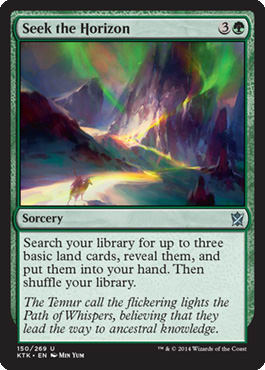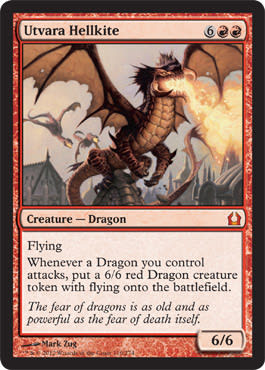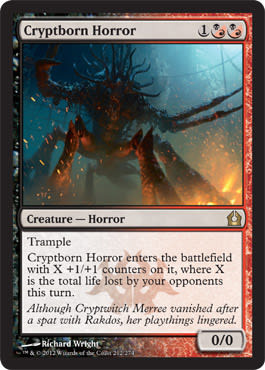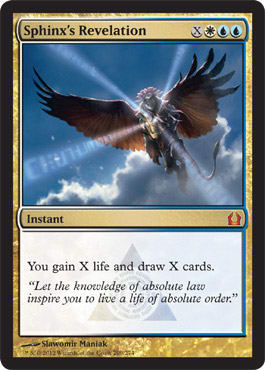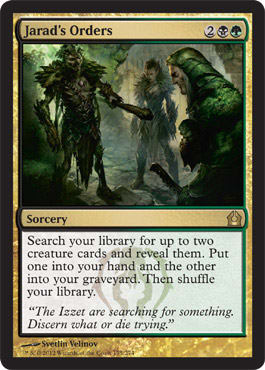When a new set arrives, it heralds conversation about what cards are good enough to make our decks. Take Commander for instance. Which cards in this set will crack into your existing Commander decks; what will be pulled? I have the same conversation about what will make the cut into Abe’s Deck of Happiness and Joy (a 2,600-plus-card, five-color, Highlander, multiplayer deck) . What cards are the best in the set?
Today, I want to toss my proverbial two cents into the discussion. Since said discussion takes place mostly in Cyberworld 2012, I’m not sure that terms such as “talk” and “discussion” qualify. Also, it’s hard to make two pennies enter the Internet anyway. With this increasingly hypothetical situation about to burst the confines of this paragraph and article, let’s digress and investigate some cards instead!
Honorable Mention 1 – Seek the Horizon – Every Top 10 list has to have at least one honorable mention. We’ll have three! Seek the Horizon’s trio of basic lands has the card-advantage potential of Harmonize combined with the land-searching of spells that usually cost 5 mana or more. This combination makes Horizon a potent package. I see many decks, both Commander and other formats, packing this card into their land-searching slots.
Honorable Mention 2 – Loxodon Smiter – Why do many players miss how powerful pure, cheap beating can be in multiplayer? Everyone assumes that you want a big creature, such as Akroma (either one) or an X-Steel Colossus (either one) in order to serve. Often, a cheap and big creature can come down three or five turns before other folks come online, and these early beaters can dole out a lot of hurt in the meantime. Then, consider that not only is the Smiter a nice 4/4 smasher of faces for 3 mana, but our good Loxodon friend also has two abilities. With the good discard in this set, the second one—putting itself into play when an opponent forces you to discard it—seems extra-nice.
Honorable Mention 3 – Chromatic Lantern – It doesn’t matter what colors you are playing; this is good. It fits into any deck with more than one color. I can even think of a few mono-colored decks where this fits in nicely. First, it taps for any color of mana; plus, it costs 3 mana. That puts it on par with cards such as Darksteel Ingot and Coalition Relic. This guy has a nasty ability, though. All of your lands can tap for any color of mana. Now your Swamps make all colors, and your Forests do as well. It fixes all mana concerns, and it accelerates your mana at the same time. That’s a powerful whammy you can’t deny. Additionally, consider a mono-colored deck that needs a lot of lands that tap for colorless mana. This now enables them to help the cause by making your color as well. Decks loaded with the Urza’s lands or Cloudposts seem like good candidates with the right cards in the deck. For example, in a Dragonstorm deck with Dragons that have red activations, now you can tap that Cloudpost for ![]() or
or ![]() —in case you just want to activate firebreathing or something.
—in case you just want to activate firebreathing or something.
Now it’s time for that Top 10 list to officially begin.
10 – Utvara Hellkite – The only mono-red card on today’s list is this Dragon of Dragons. Why do I like it enough to have on my countdown? There are two reasons I enjoy the Hellkite. The first is that it works wonders in any Dragon deck. This is a Dragon enabler of a high degree. Play it, attack with some Dragons, make some tokens, and win. When you think of Dragons that assist other Dragons, you’ll find that the list is actually quite small. Sure, there’re a few here and there, but for the most part, Dragons are isolationists. They must not like each other very much. That leads me to the other reason I love the Hellkite. You don’t need any other Dragons for this guy to work. Wait until your next turn (or use one of the roughly two thousand ways in red to give a creature haste), attack, and spit out a 6/6 for your trouble. Then, keep doing it. When the token and the Hellkite attack, you make even more friends. It’s like a Spawnwrithe that’s actually good. In multiplayer, there should always be someone you can safely attack just to twin another token or four into play.
9 – Grave Betrayal – Sure, it’s a bit expensive, but once this enchantment is down, it will run the table. It’s much like Debtors' Knell in that way. Let’s analyze why this card has so much potential. First of all, note that this card works on creatures you don’t control that die. You can own them, you just can’t control them. If you gave away a Gilded Drake or Donated a creature, you can get it back. You can re-gift your present. Most of the time, you are just going to want to return the dying creatures of your opponents. In multiplayer, the more opponents you have, the more creatures you’ll face. This brings all dead opposing creatures back but onto your side of the table. That’s great, right? What if I told you that they also receive a +1/+1 counter for your trouble? Sounds even better! Plus, they are all black Zombies, so Zombie tricks such as Call to the Grave have obvious use. Finally, they don’t return until the end of the turn, so you have some time to ready your board in the meantime. Remember that you are in the color of both mass removal and pinpoint removal. Murder and Mutilate were printed in the last set!
8 – Selesnya Charm – I like all of the Charms in this set; it was a good idea to include them. All have at least one ability that makes them really strong in multiplayer. The Azorius Charm’s first two abilities are weaker, but the last one is solid. The Golgari Charm is the second best after the Selesnya Charm, and it was on my short list for this article, but it was just narrowly cut off. The Izzet Charm can Shock, but it’s the worst in my opinion. The Rakdos Charm can hang its head either as a Shatter or by exiling a graveyard at instant speed. But this Charm, with its trio of talent, is the top of the lot. Why do I like it so?
The first ability it is worst, so let’s start there. This gives a creature +2/+2 and trample for a turn. It can be used to save a creature from dying in combat or be used all the other ways we’ve seen a Giant Growth used. It’s not exactly something I want to have in my deck regularly, but it’s nice to have the option when you need it. The third ability is nice—you can make a 2/2 vigilance Knight token at instant speed. This has a lot of uses, and I suspect this is the way you’ll play this spell. Make as surprise blocker to chump and then swing with your team. Trade with an X/2 or slay a 1/2 or a 1/1 that swings into your board. Make an additional attacker for the next turn; the uses are multiple.
Finally, the most powerful ability is to exile any creature with a power 5 or more. If you’ll recall, when discussing Loxodon Smiter above, I mentioned how frequently people play big creatures, especially in multiplayer. Take a look at a few Commander decklists online. See what percentage of that creature base this will exile. Is it a small number, like 15% or 20%? Not usually. I’ve seen decks in which more than 75% or 80% of the creatures have a power 5 or greater. This has a large array of exile targets in multiplayer. When you add that versatility to the first two abilities, you have a very powerful trinity of options with this 2-mana spell.
7 – Cryptborn Horror – This creature has the power to top this list, and yet, it has the potential to be one of the worst cards in the set. It’s a gamble. Clearly, when you have many opponents, it can spiral out of control very quickly. Just make sure your foes have lost life, and then play this guy. For example, you could play Breath of Malfegor or Sizzle. Then, follow with this. If you are playing against three others, one Sizzle turns this into a 9/9—one Breath, a 15/15. A Flame Rift costs just 2 mana and gives you a 12/12. Tap Lobber Crew to add +3/+3 permanently to your Horror. As you can see, this is a brilliant card in the right context. But if you don’t have the spells or mana, you’ll just have to attack and hope. Even then, you may wind up with a 4/4 creature that was hardly worth it. Are you willing to gamble?
6 – Underworld Connections – This is particularly good for Commander, where it’s basically Phyrexian Arena and Graveborn Muse number three. Because it is an enchantment on a land, it’s more fragile. It could die, not only to enchantment removal, but to land removal as well. An itinerant Strip Mine is the end of your connecting fun. Plus, the land you enchant has to tap to draw you a card for. You can’t use it for mana or any other abilities, so this is strictly worse than other options. Like any good Johnny, you can build around restrictions by having ways of untapping your land. Perhaps you want to dust off that Earthcraft or other cards (Stone-Seeder Hierophant anyone?).
5 – Armada Wurm – Okay, If you must play a big, stupid creature because that’s what you think multiplayer and casual Magic is, let’s do it right. Just pay 6 mana and make two 5/5 tramplers for your trouble. If one is Selesnya Charmed, you still have one more. Sure, for 6 mana, you could have a nice 6/6 flyer with some janky abilities, but you can also make two—that’s two 5/5 tramplers for your time and mana. Armada Wurm is good multiplayer math: one card equals two creatures. In case you forgot, there was this set released not too long ago called Avacyn Restored. We sometimes forget the recent for the new. It has a variety of ways to flicker or bounce this Wurm for another go and another 5/5 dork (with trample). This Wurm is cost-efficient and beat-efficient, and it plays well with others. It’s a winner.
4 – Sphinx's Revelation – I’m a bit surprised at you. There was a time when Braingeyser was believed to be so good it was restricted. Reprinting it as an instant for 1 more mana (Stroke of Genius) was considered foolhardy; it was banhammered as well. This was powerful stuff. Sure, card-drawing added guys like Tidings, Opposition, and Concentrate without issue. But let’s look under the roof. Compare Braingeyser to Tidings. For 5 mana, I draw three or four with Tidings. Compare Blaze with Volcanic Hammer, and it’s even more behind the curve, but X-mana burn spells are still worth playing due to their sheer flexibility. X-mana card-drawing spells are as well. Then, Mind Spring was printed, and oh noes! It was even reprinted in a later set, and yet, where is it? Why aren’t more people playing with such an amazing card-drawing spell? Invoke the Firemind, from the first Ravnica block, was played some in Izzet decks, so I can only hope that this awesome house is played in decks with the right colors. I’d rather draw eight cards and gain 8 life than draw nine, so the extra
3 – Martial Law – Sometimes, you want a simple card. The previous entry was a mighty eight words long—or six if you don’t count “X” as a word. That’s not the case with this card because detain needs a lot of explanation. You pay 4 mana for this enchantment. Each of your upkeeps, you can detain a creature for a round of turns until your next upkeep. What does that mean? Well for starters, it can neither attack nor block. It also cannot tap or activate any abilities. If it has static or triggered abilities, including upkeep triggers, they still apply. So for the next round of turns, that creature is basically Arrested (as the card). That means you can blast a blocker and swing, keep an intimidating creature from being a threat, or prevent an ability from someone such as Arcanis the Omnipotent. You can also switch from one creature to another, turn after turn, so you don’t play favorites. This ability to switch to creature after creature grants this card a powerful bit of versatility. Remember that this never costs any mana beyond the initial investment for 4 to play it. It sits there helping the group deal with creatures that are out of hand. It reminds me of Tawnos's Coffin. It’s not as good, obviously, but it’ll work.
2 – Jarad's Orders – Tutors are fun. I enjoy a good-card advantage tutor. Buried Alive is massive card advantage for 3 mana since the three creature cards that hit the ’yard invariably have the ability to recur themselves or give you three abilities (I find Filth, Anger, and Genesis!), and so forth. I’m also fine and dandy with tutoring cards to my hand. That’s where a certain lich’s orders come in handy. I can put a creature into my hand and one into my graveyard. That’s two cards for one! Sure, they don’t both go into your hand, but how picky can you be? I’ll stay in color for my examples. Look at Vengevine for instance. It will return very easily now that you’ve stocked your hand with a creature. Masked Admirers is another option. You have a ton of black choices from Nim Devourer to Bloodghast. Imagine if you go outside the color—say “hello” to Karmic Guide in your hand and your best creature in the graveyard. This is a card with a lot of potential.
1 – Skull Rend – Why is this card my overwhelming top choice for Return to Ravnica? First of all, it’s another option with Number 7 above. Hitting everyone for 2 damage makes me happy. But the real reason is that it’s just 1 mana more than Unnerve and it makes the discard random. Unnerve is among the most powerful discard spells at the table because it hits every player for two cards. If you have three opponents, that’s six cards you pulled for one Unnerve. But they choose the cards, so you often take the six worst cards for one Unnerve. Now you can play Skull Rend and take two random cards per opponent for one spell and 5 mana. Oh, and you get to deal 2 damage per opponent as well. This will be a powerhouse at the multiplayer table.
Sometimes at the end of an article, I’m just tempted to end with, “Decks Done!”, or “Cards Done!”, in a voice reminiscent of the old, “Files Done!”, computer voice from the 90s that would inform you when a download was finished. So, in light of this desire . . .
Cards Done!
See you next week,
Abe Sargent













